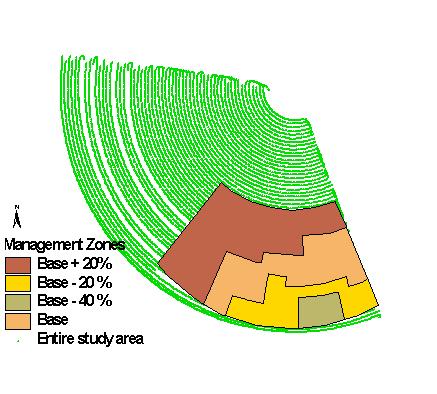(Fields 5D and 5E)
Sally J. Officer, Jill D. Booker, James P. Bordovsky, Eduardo Segarra, Ed Bynum, and Robert J. Lascano
Objectives: The objectives were to:
1) Describe the effects of site-specific water, nutrient, and pest management on growth and production in an irrigated corn system in rotation with cotton.
2) Quantify the economic and environmental cost-benefit of managing multiple stresses in site-specific compared to conventional systems.
Methodology: The Watson and Segarra economic model, based on 2000 – 2001 corn data at Helms, indicated that applying less water to sandy sloping areas and re-distributing the saved water to heavier textures soils on the field would increase overall profit. Soil sampling done in March 2003 along with soil electrical conductivity (EC) measurements taken with a VerisÒ 3100 system (VerisÒ Technologies, Salina, KS) were used to delineate four Crop Management Zones (CMZ) based on soil texture and slope in field 5D (Fig. 1). Irrigation in each CMZ was managed using a Base Rate (BR) of 80% of the calculated evapotranspiration rate of the corn crop as follows: 1) BR (seasonal total of 19.6”), 2) BR plus 20% on heavier clay soils (total 22.2”), 3) BR minus 20% for the sandier level areas (total 17.0”), and 4) BR minus 40% on sandy sloping areas (total 14.5”). Pioneer 3223 corn was planted on 23 April at a rate of 28,000 seed/acre. Normal cultural practices were uniformly applied across fields 5D and 5E.
Throughout the growing season crop growth, leaf reflectance and soil moisture were measured. Also, leaf area index, nitrogen and carbon content and dry matter accumulation were calculated. Grain yield samples, lodge ratings and Southwestern corn borer damage were recorded 4-5 Sep. Both fields were harvested with a John Deere GreenstarÒ yield monitor on 12 Oct.
Results: Preliminary results indicate that the establishment of the CMZ’s based on soil texture and slope and that the selected criteria of applying less water to sandy sloping areas and more water to heavier textured soils in fact increased grain yield. Corn from the CMZ produced 1000 lbs/acre more grain when compared to the adjacent field that was uniformly watered. Higher grain yields were achieved with increased water applications on the heavier textured soils without compromising the grain yield from the less watered sandy areas. Results from this year suggest that the creation of CMZ increased both grain yield and profitability.


